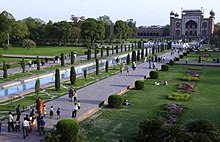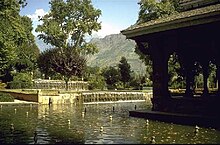Mughal Gardens in India, Pakistan and Afghani
Mughal gardens are a group of gardens built by the Mughals in the Persian style of architecture. This style was heavily influenced by the Persian gardens particularly the Charbagh structure. Significant use of rectilinear layouts are made within the walled enclosures. Some of the typical features include pools, fountains and canals inside the gardens.
Contents
[hide]History
The founder of the Mughal empire, Babur, described his favourite type of garden as a charbagh. They use the term bāgh,baug, bageecha or bagicha for garden. This word developed a new meaning in India, as Babur explains; India lacked the fast-flowing streams required for the Central Asian charbagh. The Agra garden, now known as the Ram Bagh, is thought to have been the first charbagh. India, Bangladesh and Pakistan have a number of Mughal gardens which differ from their Central Asian predecessors with respect to "the highly disciplined geometry". An early textual references about Mughal gardens are found in the memoirs and biographies of the Mughal emperors, including those of Babur, Humayun and Akbar. Later references are found from "the accounts of India" written by various European travellers (Bernier for example). The first serious historical study of Mughal gardens was written by Constance Villiers-Stuart, with the title Gardens of the Great Mughals (1913). Her husband was a Colonel in Britain's Indian army. This gave her a good network of contacts and an opportunity to travel. During their residence at Pinjore Gardens, Mrs. Villiers-Stuart also had an opportunity to direct the maintenance of an important Mughal garden. Her book makes reference to the forthcoming design of a garden in the Government House at New Delhi (now known as Rashtrapati Bhavan). She was consulted by Edwin Lutyens, and this may have influenced his choice of Mughal style for this project. Recent scholarly work on the history of Mughal gardens has been carried out under the auspicious guidance of Dumbarton Oaks (including Mughal Gardens: Sources, Places, Representations, and Prospects edited by James L. Wescoat, Jr. and Joachim Wolschke-Bulmahn) and the Smithsonian Institution. Some examples of Mughal gardens are Shalimar Gardens (Lahore), Lalbagh Fort at Dhaka, and Shalimar Bagh (Srinagar).
From the beginnings of the Mughal Empire, the construction of gardens was a beloved imperial pastime. Babur, the first Mughal conqueror-king, had gardens built in Lahore and Dholpur. Humayun, his son, does not seem to have had much time for building—he was busy reclaiming and increasing the realm—but he is known to have spent a great deal of time at his father’s gardens. Akbar built several gardens first in Delhi, then in Agra, Akbar’s new capital. These tended to be riverfront gardens rather than the fortress gardens that his predecessors built. Building riverfront rather than fortress gardens influenced later Mughal garden architecture considerably.
Akbar’s region, Jahangir, did not build as much, but he helped to lay out the famous Shalimar garden and was known for his great love for flowers. Indeed, his trips to Kashmir are believed to have begun a fashion for naturalistic and abundant floral design.
Jahangir's son, Shah Jahan, marks the apex of Mughal garden architecture and floral design. He is famous for the construction of the Taj Mahal, a sprawling funereal paradise in memory of his favorite wife, Mumtaz Mahal. He is also responsible for the Red Fort at Delhi which contains the Mahtab Bagh, a night garden that was filled with night-blooming jasmine and other pale flowers. The pavilions within are faced with white marble to glow in the moonlight. This and the marble of the Taj Mahal are inlaid with semiprecious stone depicting scrolling naturalistic floral motifs, the most important being the tulip, which Shah Jahan adopted as a personal symbol.
Design and symbolism
Mughal gardens design derives primarily from the medieval Islamic garden, although there are nomadic influences that come from the Mughals’ Turkish-Mongolian ancestry. Julie Scott Meisami describes the medieval Islamic garden as “ahortus conclusus, walled off and protected from the outside world; within, its design was rigidly formal, and its inner space was filled with those elements that man finds most pleasing in nature. Its essential features included running water (perhaps the most important element) and a pool to reflect the beauties of sky and garden; trees of various sorts, some to provide shade merely, and others to produce fruits; flowers, colorful and sweet-smelling; grass, usually growing wild under the trees; birds to fill the garden with song; the whole cooled by a pleasant breeze. The garden might include a raised hillock at the center, reminiscent of the mountain at the center of the universe in cosmological descriptions, and often surmounted by a pavilion or palace.” The Turkish-Mongolian elements of the Mughal garden are primarily related to the inclusion of tents, carpets and canopies reflecting nomadic roots. Tents indicated status in these societies, so wealth and power were displayed through the richness of the fabrics as well as by size and number.
The Mughals were obsessed with symbol and incorporated it into their gardens in many ways. The standard Quranic references to paradise were in the architecture, layout, and in the choice of plant life; but more secular references, including numerological and zodiacal significances connected to family history or other cultural significance, were often juxtaposed. The numbers eight and nine were considered auspicious by the Mughals and can be found in the number of terraces or in garden architecture such as octagonal pools.
Sites of Mughal gardens
Afghanistan
India
- Humayun's Tomb, Nizamuddin East, Delhi
- Taj Mahal, Agra
- Ram Bagh, Agra
- Mehtab Bagh, Agra
- Safdarjung's Tomb
- Shalimar Bagh (Srinagar), Jammu and Kashmir
- Nishat Gardens, Jammu and Kashmir
- Yadavindra Gardens, Pinjore
- Khusro Bagh, Allahabad
- Roshanara Bagh
- Brindavan Gardens, Mysore, Karnataka (1927-1932)
- Rashtrapati Bhavan, New Delhi (1911-1931)
- Vernag
- Chashma Shahi
- Pari Mahal
- Achabal Gardens
Pakistan
- Chauburji
- Lahore Fort
- Shahdara Bagh
- Shalimar Gardens (Lahore)
- Tomb of Jahangir, Lahore
- Hazuri Bagh
- Hiran Minar (Sheikhupura)
- Mughal Garden Wah
Other Gardens in Delhi
Buddha Garden Delhi
Buddha Jayanti Park is situated in South Delhi, on the Ridge Road, near Dhaula Kuan. The park was built in the commemoration of the 2500th anniversary of Lord Gautam Buddha's attainment of nirvana. The picturesque garden boasts of paved pathways, lush landscaped lawns, blossoming flowers, streams, sloping terrain and huge trees.
Deer Park Delhi
Deer Park of Delhi is situated in the Chankyapuri area and is easily accessible from Hauz Khas Village and Safdarjung Enclave. An expanse of green stretch in the urban jungle of Delhi, it is the perfect place to find some calm and peace. The Deer Park at Delhi has been beautifully landscaped with shady trees and flourishing grasses, along with a tranquil water body.
Garden of Five Senses Delhi
Garden of Five Senses in Delhi is situated in the Said-ul-Ajaib village, near Mehrauli-Badarpur Road. Developed by the Delhi Tourism Transportation Development Corporation, it was inaugurated in the year 2003. As its name suggests, Garden of Five Senses in Delhi was set up in a way to stimulate our five senses with its beauty and attractions.
Lodi Garden Delhi
Lodi Garden of Delhi is situated on the Lodi road, near the famous Safdarjung Tomb. Earlier known as Lady Willington Park, the Lodi garden boasts of splendidly landscaped lawns. Small water bodies, fountains, a jogging track, etc, are the main features of this garden.
Mughal Gardens Delhi
Mughal Gardens of Delhi are situated inside the Rashtrapati Bhavan complex. Sir Edwin Lutyens designed these gardens, sprawling across six hectares, for Lady Harding. These gardens combine the formal Moghul style with the British garden designs and sport Mughal canals, multi-level terraces and flowering shrubs along with European flowerbeds, lawns and privet hedges.
Nehru Park Delhi
Nehru Park of Delhi is situated on the main Panchsheel Road, near Chanakyapuri Diplomatic Enclave. Spread over an area of almost 80 acres, the park boasts of a dazzling collection of blossoming flowers. Then, there are little mounds and rocks inscribed with the sayings of India's first Prime Minister Jawahar Lal Nehru, after whom the park is named.
Shahajahanabad Gardens Delhi
Shahajahanabad Gardens at Delhi date back to the time when Emperor Shah Jahan ruled over the city. One of the favorite summer jaunts of the Emperor, the Shahajahanabad Gardens also served as the venue for the celebration of various festivals by the ladies of the court.
Shalimar Garden Delhi
Shalimar Garden is situated to the west of Delhi-Karnal road, at a distance of approximately 10 km from the capital city. The garden served as the venue of the crowning ceremony of the Mughal emperor Aurangzeb. Originally known as the Aizzabad Bagh, Shalimar Garden once consisted of a magnificent palace known as the Shish-Mahal, which stood at its center.
Talkatora Gardens Delhi
Talkatora Gardens are situated on the main Willingdon Crescent Road in New Delhi. The place where the gardens now stand once housed a huge walled tank. Although the tank has been replaced by a relatively small swimming pool, it is still named after it (tal means tank and katora means cup).
Mahatma Gandhi Park Delhi
The Mahatma Gandhi Park of Delhi is situated behind the Town Hall building on the main Church Mission Road, near Old Delhi Railway Station. Not a very ostentatious park, it is more popular because of its historical significance. The park was originally set up during the British period and was officially known as "Queen's Park". However, amongst the masses, it came to be known as the "Company Bagh". In the early part of the 19th century, Company Bagh functioned as the outdoor club for Delhi's high-class society.The park got renamed as the Mahatma Gandhi Park, after India attained independence in the year 1947. It boasts of a number of trees that provide relief from the scorching heat of summers, along with a statue of Mahatma Gandhi. The Mahatma Gandhi Park is a source of an open-air space for the residents of the congested Chandni Chowk area. Apart from that, it also serves as the venue for various cultural and social activities during the festival season.
Netaji Subhash Park Delhi
Netaji Subhash Park of Delhi is situated on Netaji Subhash Marg, opposite Sunehri Masjid in the old city. It is a rather small park that adjoins another park known as the Urdu Park. Delhi Netaji Subhash Park is quite famous as a place with a lot of malishwallahs (body masseurs). Infact, many people come here to get a body massage from the excellent masseurs present here. The Netaji Subhash Chandra Bose park in Delhi also houses an impressive statue of Netaji Subhash Chandra Bose in the attire of a military leader. The statue stands as a kind of reminder to the people of this great leader who formed the Indian National Army (INA) to fight the British forces.
https://linksredirect.com/?pub_id=11719CL10653&subid=5&url=https%3A//linksredirect.com/%3Fpub_id%3D11719CL10653%26url%3Dhttp%3A//www.americanswan.com/

















No comments:
Post a Comment